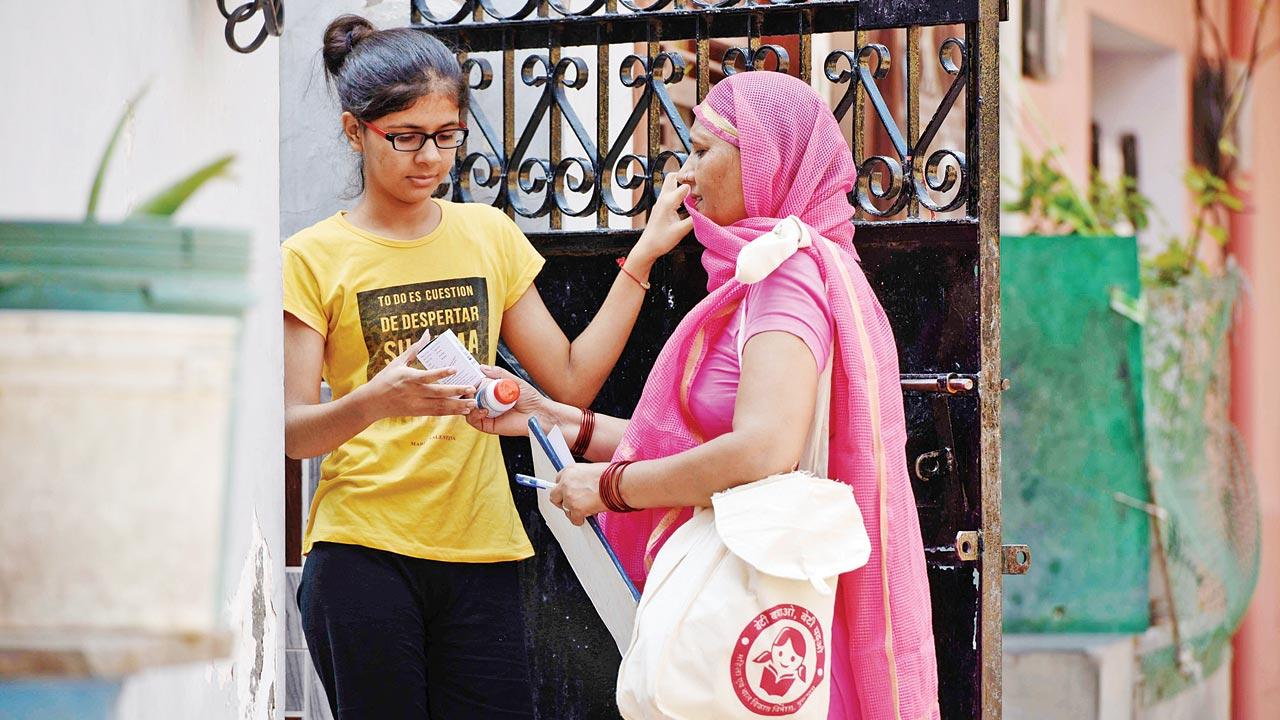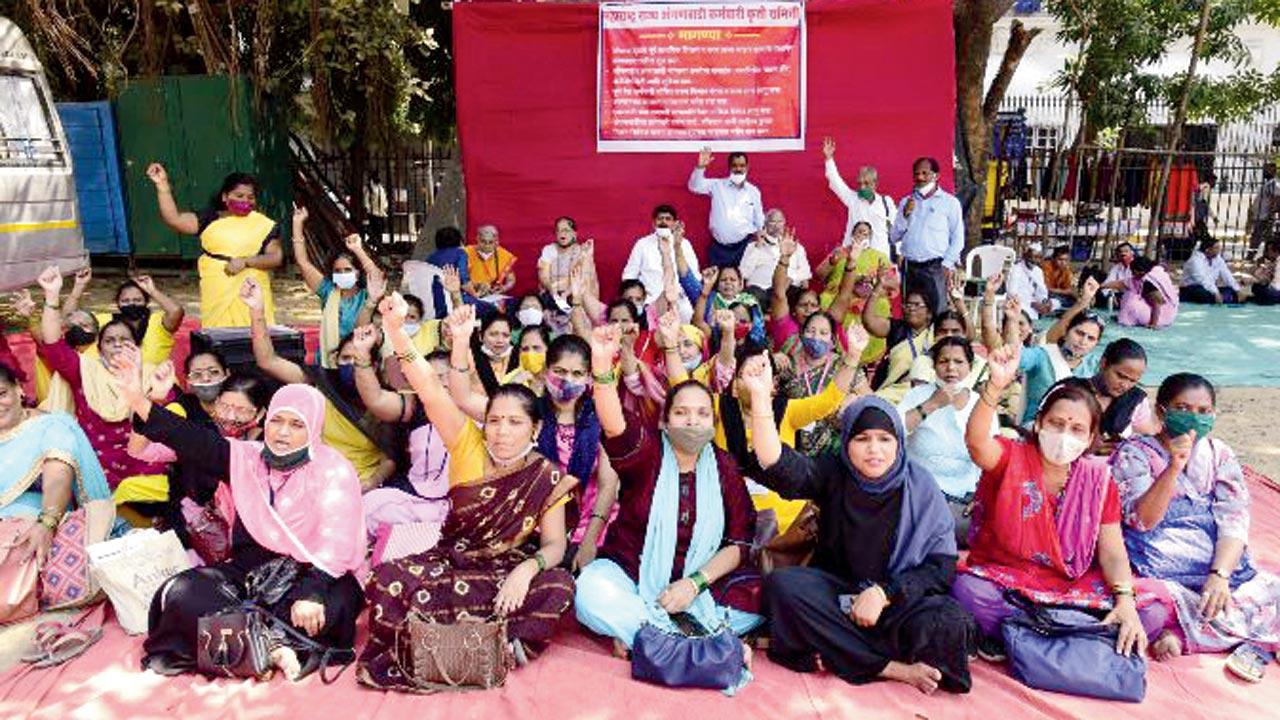A just-aborted protest in Mumbai that’s one of several across the country by Anganwadi workers who are indispensable to the country’s child and women welfare goals, points to a government with shifty intentions to strengthen public health

Kids at an Anganwadi centre in Agartala, Tripura. Pic/Getty Images
Trupti Raju Pathare made her way last Wednesday from her Nehru Nagar home in Kurla to Azad Maidan in South Mumbai, leaving her husband who almost suffered a stroke late last year, alone. She thinks it was a day well spent. Pathare, together with other Anganwadi workers (AWs), had gathered for a three-day protest to demand higher wages from the state government. Maharashtra pays an Anganwadi worker Rs 8,500 a month, while a helper receives Rs 4,500. The 2.12 lakh AWs in the state want their pay raised to Rs 15,000. The women say, it’s not a wage, but an honorarium since they are considered volunteers, not government workers.
ADVERTISEMENT
This, the AWs find hard to digest because they are community-based frontline workers of the Integrated Child Development Services (ICDS) department. Agents of social change, Anganwadi workers play a crucial role in promoting child growth and development. Their responsibilities span a wide gamut from weighing children and maintaining referral cards to organising informal pre-school teaching activities at the anganwadi or community centre, to counselling expecting mothers on nutrition, helping the Primary Health Centre (PHC) staff with immunisation, pre- and post-natal checkups, identifying early disability among children during home visits and referring the case to the nearest PHC, and helping with implementing the Kishori Shakti Yojana (KSY) to motivate adolescent girls and their parents by organising social awareness drives.
 An Anganwadi worker delivers medicine in a containment zone in Gurugram. Pic/Getty Images
An Anganwadi worker delivers medicine in a containment zone in Gurugram. Pic/Getty Images
During the pandemic, their role became even more critical as foot soldiers who’d keep a check on the health of residents in their jurisdiction, collect data, and deliver medicines to those locked up in containment zones.
Pathare does the math for us. When she joined the force in 1992, she got paid Rs 275. She has managed no savings for a rainy day like the one when she had to borrow from friends and family to admit her husband to hospital. From the Rs 8,500 she now makes, she must run the home as the sole breadwinner and pay the medical bills. “Once he got out of hospital, his follow up treatment was costing me Rs 3,000 a week. I had not received my salary for December 2021 and January of this year. I had no choice but to stop treatment. I have already gathered a debt of Rs 1,28,000. Now, he is at the mercy of God.”
 Anganwadi workers protesting for an increase in their honorarium and a pension scheme at Azad Maidan Pic/Suresh Karkera
Anganwadi workers protesting for an increase in their honorarium and a pension scheme at Azad Maidan Pic/Suresh Karkera
Among the demands is a monthly pension scheme that assures them 50 per cent of their last withdrawn salary, the status of permanent employees, hike in the allowance to rent a premise to run an anganwadi, and a good smartphone to run the Centralised Poshan Tracker app where they must feed data.
Last Thursday, the protest in Mumbai was called off after receiving an assurance from the Women and Child Development (WCD) department. Activists say the AWs were promised an increase in the honorarium and an additional Rs 10,000 to buy phones that support the Poshan Tracker app. Pathare and her friends are hopeful that the government will consider making the app Marathi-friendly; most of them struggle to negotiate English while collecting and uploading data. But they plan to continue the agitation at the district level, and hold a morcha on March 9 before the Zilla Parishad offices.
 Dr Kalpana Apte, Trupti Pathare and Sneha Sawant
Dr Kalpana Apte, Trupti Pathare and Sneha Sawant
In Delhi though, where close to 10,000 AWs have been sitting in on protest outside Chief Minister Arvind Kejriwal’s home for close to a month, the group has refused to end their dharna despite an offer from Social Welfare Minister Rajendra Pal Gautam last Thursday to increase the honorarium from Rs 6,810 to Rs 12,720. They argue that it’s too little. Their demand is Rs 25,000 and Rs 20,000 for AWs and helpers respectively.
Things are no better in Haryana where AWs have been protesting since December 8. Most women associated with the ICDS, a flagship programme launched by the government in 1975 for early childhood care and development, belong to the lower socio-economic strata and share their family’s financial burden if not shoulder it entirely. Harshda Pawar, 48, is a helper at an anganwadi in Raju Gandhi Nagar, Goregaon East. Her husband is paralysed, and her son met with an accident that has left him unable to work. “I begin work at 10.30 am and wrap up by 3.30 in the afternoon. I am the first to arrive at the centre to sweep the floors and keep things ready before the teachers and kids arrive. My job is to take care of the children; I snip their nails, help them use the washroom, and feed them. I also help the teachers measure the height and weight of the children when they are busy with meetings. We keep them busy with singing rhymes and fun activities. Once class is over, I do the dishes and clean the centre before calling it a day,” says Pawar, adding that her efforts deserve no less than Rs 10,000 monthly.
Fifty-eight-year-old Sneha Sawant, an Anganwadi teacher in Bhandup, says most of the women are widows, single mothers or have retired husbands to support. “They have no one to reach out to. They rely only on this job. If the idea is to take up the cudgels for women who lack support through employment with Anganwadis, how are we truly empowering them if we don’t agree to fair wages? We will earn more if we sweep and swab at a few homes.” Namrata Gajanan Chauhan, 59, a helper has taken up the job of a house help during the evening hours to pay her bills.
Leading the women in Mumbai is Shubha Shamim, Maharashtra General Secretary of the Anganwadi Karamchari Sangathan. “The government sees this as part-time work; it is anything but that. The responsibilities take up eight hours of their day, and more now with digitisation. Entering data into the app takes up four hours a day. I know of some AWs who are diligently doing this as late as midnight. Wages must be fair, and in keeping with rising inflation,” she thinks, adding, “And we must look after them once they are done. These women put in 30 to 40 years of their productive lives into this job. AWs get a one-time amount of R1 lakh on retiring, and it’s R75,000 for helpers. It’s hardly sufficient to meet a senior citizen’s post-retirement needs. The monthly pension which we are fighting for is their safeguard.”
While this concerns individual benefits, the AWs rue that the government has been equally stingy in spending on the work itself. The rent that the Maharashtra government allots to rent an anganwadi centre is Rs 750 a month. The women say it’s impossible to find premises to conduct business in the pittance. “Even in a slum like Dharavi, where the rent for a jhugi-jhopdi is Rs 25,000, how do we find a room to rent for Rs 750? We are asking for the rent allowance to be raised to Rs 3,000-Rs 6,000 in cities and Rs 1,000-Rs 3,000 in rural areas,” Shamim shares.
While digital first has been the mantra of the ruling government at the Centre, the infrastructure needed to support the dream is wanting. In September 2021, Maharashtra’s AWs made headlines when they decided to return 80,000 of the 1,50,000 phones they had been handed to work on the Poshan Tracker app launched in March 2021 by the Ministry of Women and Child Development. The 2G RAM smartphones did not support the app where the women were meant to enter data on children, lactating mothers and pregnant women in addition to uploading photographs, which the AWs complained was slowing down their devices.
“Poshan Tracker doesn’t support Marathi. It should allow both English and Marathi. It has doubled our work because we have to enter the information first in registers before updating it on the app. We aren’t paid for data recharge or reimbursed if the phone needs repairs,” says one of the protesting women requesting anonymity. “If the Anganwadi workers don’t feed in data daily, they are marked absent,” says Kamal Parulekar, General Secretary, Anganwadi Karamchari Sabha. Shamim agrees. “Almost 70 per cent of AWs can’t enter the details into the app in English, especially those in rural areas. They didn’t get new phones but at a meeting, we were promised that R10,000 would be deposited in every AW’s account to buy a new phone. We are yet to see that money.”
This, despite them being the crutches of primary health care together with ASHA (Accredited Social Health Activist) workers during the Coronavirus pandemic, who made community engagement a successful strategy to enhance the country’s response to COVID. “During the first and second waves, most people feared that if they went into isolation in hospitals, they wouldn’t return. We allayed their fears, and helped those in need find hospital beds. To those with mild symptoms, we explained the quarantine process. We distributed dry ration across homes and checked on pregnant and lactating mothers when they didn’t have access to health care centres since the country had shut down,” says Pathare. Those, like her, who were officially asked to conduct surveys were paid Rs 100 a day for a one-week stint. Shagufta Sheikh, 45, says she is one of the unlucky few who is yet to be paid for COVID duty, including door-to-door visits to report fever and cold cases.
Dr Kalpana Apte, Director General, Family Planning Association of India, believes that AWs have played a vital role especially during immunisation drives in hard to reach and tribal areas, and counselling women about contraception and the importance of spacing out childbirth. “It has brought a significant change on the ground. Their role can’t be overlooked. But I think there is acceptance and appreciation for what they do.”
Shamin and other union leaders hope, though, that the appreciation translates into real benefits. “We have had a promising meeting with Idzes Kundan, Principal Secretary, Department of Women and Child Development, Government of Maharashtra. They are ready to launch the contributory pension scheme, raise the rent allowance and flexi fund for stationery and miscellaneous expenses. We are hopeful.”
5,130
Total number of Anganwadi workers in Mumbai
How the states match up
Rs 12,661 monthly honorarium in Haryana
Rs 9,678 Delhi
Rs 9,500 in Punjab
Rs 8,500 in Maharashtra
Rs 6,500 in Chhattisgarh
 Subscribe today by clicking the link and stay updated with the latest news!" Click here!
Subscribe today by clicking the link and stay updated with the latest news!" Click here!







